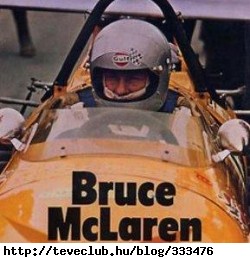Tartalomjegyzék
A napló közvetlen linkje
http://teveclub.hu/naplo/
|
Bruce McLaren
Bruce Leslie McLaren (August 30, 1937 – June 2, 1970), born in Auckland, New Zealand, was a race-car designer, driver, engineer and inventor.
His name lives on in Team McLaren which has been one of the most successful
in Formula One championship history, with McLaren cars and drivers winning a total of 20 world championships. McLaren cars totally dominated CanAm sports
car racing with 56 wins, a considerable number of them with him behind the wheel, between 1967 and 1972 (and five constructors’ championships), and have won three Indianapolis 500 races, as well as 24 Hours of Le Mans and 12 Hours of Sebring.
As an eleven-year-old, McLaren contracted Perthes disease in his hip which left his left leg shorter than the right. He spent two years in traction, but later often had a slight limp.
Les and Ruth McLaren, his parents, owned a service station and workshop in Remuera, Auckland. Bruce spent all of his free hours hanging around the workshop. The McLaren family homestead is located in Ngaruawahia in the Northern Waikato region and still stands today.
Les McLaren restored an aging Austin 7 Ulster which 14-year-old Bruce used in 1952 when he entered his first competition, a hillclimb. Two years later he took part in his first real race and showed promise. He moved up from the Austin to a Ford 10 special and an Austin-Healey, then an F2 Cooper-Climax sports. He immediately began to modify and improve it—and master it—so much so that he was runner-up in the 1957–8 New Zealand championship series.
His performance in the New Zealand Grand Prix in 1958 was noted by great Australian driver Jack Brabham (who would later invite McLaren to drive for him). Because of his obvious potential the New Zealand International Grand Prix organisation selected him for its ‘Driver in Europe’ scheme designed to give a promising Kiwi driver year-round experience with the best in the world. McLaren was the first recipient, to be followed by others later including Denny Hulme.
McLaren went to Cooper and stayed seven years. He raced in F2 and was entered in the German Grand Prix at the Nürburgring in which F2 and F1 cars competed together. He astounded the motor racing fraternity by being first F2, and fifth overall, in a field of the best drivers in the world.
McLaren joined the Cooper factory F1 team alongside Jack Brabham in 1959 and won the 1959 United States Grand Prix at age 22 years 80 days, becoming the youngest ever GP winner up to that time. He followed that with a win in the Argentina Grand Prix, the first race of the 1960 Formula One season, and he would finish runner-up that season to Brabham. (Forty three years later, another Kiwi racer, Scott Dixon, would become the youngest ever winner in any major open-wheel racing formula anywhere in the world when he won the CART Nazareth (Pennsylvania, USA) 225 when 20 years, 9 months and 14 days old.)
McLaren won the Monaco Grand Prix in 1962, eventually finishing a fine 3rd in the championship that year. The next year he founded Bruce McLaren Motor Racing Ltd, which remains in the Formula One championship simply as Team McLaren. McLaren continued to race and win in Coopers (including the New Zealand GP in 1964).
McLaren left Cooper at the end of 1965, and announced his own GP racing team, with co-driver and fellow Kiwi Chris Amon. Amon left in 1967 to drive for Ferrari. In 1968, McLaren was joined by another fellow Kiwi Denny Hulme, who had become world champion in 1967 with Brabham. McLaren took his fourth career win racing his own McLaren car at Spa in 1968, achieving the team's first Grand Prix win. Hulme won twice in the McLaren-Ford. The 1969 championship was also a success, with McLaren finishing 3rd in the standings despite taking no wins. In tribute to his homeland, McLaren's cars featured the "speedy Kiwi" logo.
It was in powerful sports car racing where McLaren's design flair and ingenuity were graphically demonstrated. Just as the Can-Am began to become very popular with fans in Canada and the U.S., the new McLaren cars finished second twice, and third twice, in six races.
In 1967 they won five of six races and in 1968, four of six. The following year McLarens proved unbeatable, winning 11 of 11 races. In two races, they finished 1-2-3. (McLaren, Hulme and Mark Donohue).
In 1966 he and co-driver Chris Amon won the prestigious 24 Hour race at Le Mans in a Ford GT40.
Bruce McLaren died (aged 32) when his Can-Am car crashed on the Lavant Straight just before Woodcote corner at Goodwood Circuit on June 2 1970 in England. He had been testing his new M8D when the rear body work came adrift at speed. The loss of aerodynamic downforce destabilized the car, which spun, left the track and hit a bunker used as a flag station.
Motorsport author Eoin Young has noted that Bruce McLaren had "virtually penned his own epitaph" in his 1964 book From the cockpit. Referring to the death of team mate Timmy Mayer, McLaren had written:
"The news that he had died instantly was a terrible shock to all of us, but who is to say that he had not seen more, done more and learned more in his few years than many people do in a lifetime? To do something well is so worthwhile that to die trying to do it better cannot be foolhardy. It would be a waste of life to do nothing with one’s ability, for I feel that life is measured in achievement, not in years alone."
Formula One World Championship career
Active years...............1958 - 1970
Teams........................McLaren, Cooper, Eagle
Races.........................104 (100 starts)
Championships..........0
Wins..........................4
Podiums....................27
Career points.............188.5 (196.5)
Pole positions............0
Fastest laps................3
First race....................1958 German Grand Prix
First win....................1959 United States Grand Prix
Last win.....................1968 Belgian Grand Prix
Last race.....................1970 Monaco Grand Prix
|






